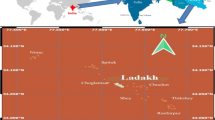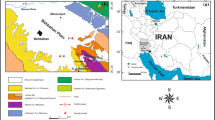Abstract
Objective: We aim to describe the environment iodine concentration in salt, water and soil along Zhejiang Province coast in the China foreland. It will be helpful for us to judge whether this area is insufficient in iodine and universal iodized salt is necessary or not. Methods: We collected iodized salt samples, drinking water samples (tap water in the towns, and well water or spring water in the villages), water samples from different sources (ditches, lakes, rivers) and soil samples through random sampling in June, 2005. Salt, water and soil iodine was detected by arsenic-cerium redox method. Statistical analysis was expressed as mean±SEM by Windows SPSS 13.0. Results: (1) The iodine concentration in salt was 27.9±4.33 mg/kg (n=108). (2) Seventy-five water samples were collected. The water iodine value was 0.6:_84.8 µg/L (mean of 11.66 µg/L). The watershed along the Qiantang River has significantly higher iodine content than the water in Lin’an in mountain area (P<0.01). The iodine content and mean iodine content of tap water, well or spring water and natural water sources were 4.30±2.43 µg/L (n=34), 23.59±27.74 µg/L (n=19) and 12.72±10.72 µg/L (n=22) respectively. This indicated that among environmental water sources, the ditch iodine content was the highest with river water iodine being the lowest (P<0.01). (3) Soil iodine value was 0.11:_2.93 mg/kg (mean of 1.32 mg/kg). Though there was no statistical difference of soil iodine in different districts (P=0.131), soil iodine content correlated positively with water iodine content. Conclusion: Iodine concentration in salt accords with national policy of adding iodine in salt. Foreland has more iodine in water than mountain area. The data reflected that water and soil iodine in foreland area was not high, which suggests universal iodized salt should be necessary. Environment iodine has relatively close association with pollution.
Similar content being viewed by others
References
Chen, H.Z., 2001. Practical Internal Medicine. People’ Medical Publishing House, Beijing, p.883–885 (in Chinese).
Chen, B.H., Guo, W.H., Shi, W., Kan, H.D., 2002. Risk assessment of extremely high or low necessary trace elements intake. Chin. J. Prev. Med., 36:414–417.
Fuge, R., Johnson, C.C., 1986. The geochemistry of iodine. Environ. Geochem. Health, 8:31–54.
Kelly, F.C., Snedden, W.W., 1960. Prevalence and Geographical Distribution of Endemic Goitre. In: WHO Monograph Series: WHO, Geneva, p.27–233.
Laurberg, P., Bulow, P.I., Knudsen, N., Ovesen, L., Andersen, S., 2001. Environmental iodine intake affects the type of nonmalignant thyroid disease. Thyroid., 11:457–469. doi: 10.1089/105072501300176417.
Marrack, P., Kappler, J., Kotzin, B.L., 2001. Autoimmune disease: why and where it occurs. Nat. Med., 7:899–905. doi: 10.1038/90935.
Rose, N.R., Bonita, R., Burek, C.L., 2002. Iodine: an environmental trigger of thyroiditis. Autoimmun. Rev., 1:97–103. doi: 10.1016/S1568-9972(01)00016-7.
WHO, 2002. Micronutrient Deficiency-Iodine Deficiency Disorders. http://www.who.int/nut/idd.htm.
Zheng, Q.S., Dai, Z., Ma, Y., 2002. Current situation and strategy of prevention and cure of iodine-deficiency diseases in China. Chin. J. Epidemiol., 23:243 (in Chinese).
Author information
Authors and Affiliations
Additional information
Project (No. C200221) supported by the Environmental Protection Foundation of Hangzhou City, China
Rights and permissions
About this article
Cite this article
Lu, Yl., Wang, Nj., Zhu, L. et al. Investigation of iodine concentration in salt, water and soil along the coast of Zhejiang, China. J. Zhejiang Univ. - Sci. B 6, 1200–1205 (2005). https://doi.org/10.1631/jzus.2005.B1200
Received:
Accepted:
Published:
Issue Date:
DOI: https://doi.org/10.1631/jzus.2005.B1200




